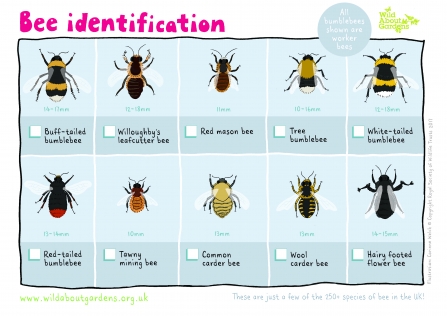Build a bee hotel fit for a queen
Bug hotel, insect house, mason mansion, air bee n' bee; whatever you want to call it, get creative and help to provide a rest stop for these hard-working pollinators!
Unlike the familiar bumblebee, mason bees are solitary and the female spends most of her life searching for hollow stems in which to lay her eggs. If you can provide a suitable home, she’ll come to you.
Creating a habitat for bees should only take an hour or two. Then you can sit back, relax, and watch the bees scurry and buzz around your garden!
Designing your Air Bee n' Bee
From minors to masons, different bee species choose a variety of places to set up home. Provide long and short grass in your garden as both serve as potential nesting sites for different species of bee.
You can now buy a variety of artificial homes for bees and other insects, or you can have a go at making your own! Our guide below is perfect for mason bees.
You will need...
- An untreated wooden plank, at least 10cm wide
- Plenty of hollow stems such as bramble, hogweed, reed or bamboo, you’ll need a wide range of diameters, bees prefer 3-5mm
- Saw, drill, screws and secateurs
- A mirror fixing to hang the finished nest up
Step by step
- Cut the plank into four to make a rectangular frame
- Drill guide holes for the screws (to stop the wood splitting) and assemble the frame
- Snip your stems into plank-width lengths, discarding any bent or knobbly ones; it's a good idea to include some really big stems (cut with a fine saw), even though they’re no use to the bees, they speed up the assembly stage, look attractive and help shelter lacewings and ladybirds over winter
- Lay your frame on a tilted surface and carefully pack it with stems, only as you add the final few does the whole thing suddenly lock solid
Hanging your Air Bee n' Bee
Hang your bee n' bee on a sunny wall, sheltered from rain, and wait for the bees to investigate in spring.
The female mason bee will select a stem and lay an egg inside with a store of pollen for the grub to eat when it hatches. Then she’ll seal up the cell with a plug of mud, and start again. A stem can end up with several cells and the young bees will emerge next year.
Helping bees in your garden
It's easier than you think to make your garden a haven for bees and other pollinators! By growing a range of plants with different flowering times, you can ensure a year round food source for pollinators.
Plant nectar and pollen rich flowers
Feed the bees! Plant a diverse range of nectar-rich flowering plants and shrubs that bloom at different times of the year. Great choices include borage, cornflowers, seedum, sunflowers, ivy, Aubretia, scabious, hebe, winter flowering crocus and winter flowering hellebore.
Provide a water source
Many of the bees in your garden need a source of water as much as nectar and pollen, especially on a hot day. Honey bees live together in swarms and will use the water as air conditioning to cool down the hive.
Why not create a wildlife pond? Or alternatively, how about a pot sunk into the ground, or a bird bath containing a few submerged rocks to enable bees to reach the water?
Encourage natural predators
Try to avoid chemicals like pesticides or fungicides in your garden. Instead, encourage natural predators. Log piles are great for beetles, as are compost bins, which also take care of your food waste!

Slow worm - Dean Eades
Help a tired bumblebee
If you see a bumblebee on the ground it’s likely to be tired and in need of food. You can help by mixing sugar with water, placing on a teaspoon and leaving it in front of the bee. Once it’s eaten its fill, it will ‘bee’ on its way!

Lydia Rose-Cox
Bee identification
Did you know there's nearly 250 species of bee in the UK! Here's just a few of the species you're most likely to come across in your garden.

More actions for wildlife
There's lots of small things you can do in your garden, courtyard of windowsill that will benefit wildlife. Take a look at some simple ideas below to see how you can take action for wildlife.




